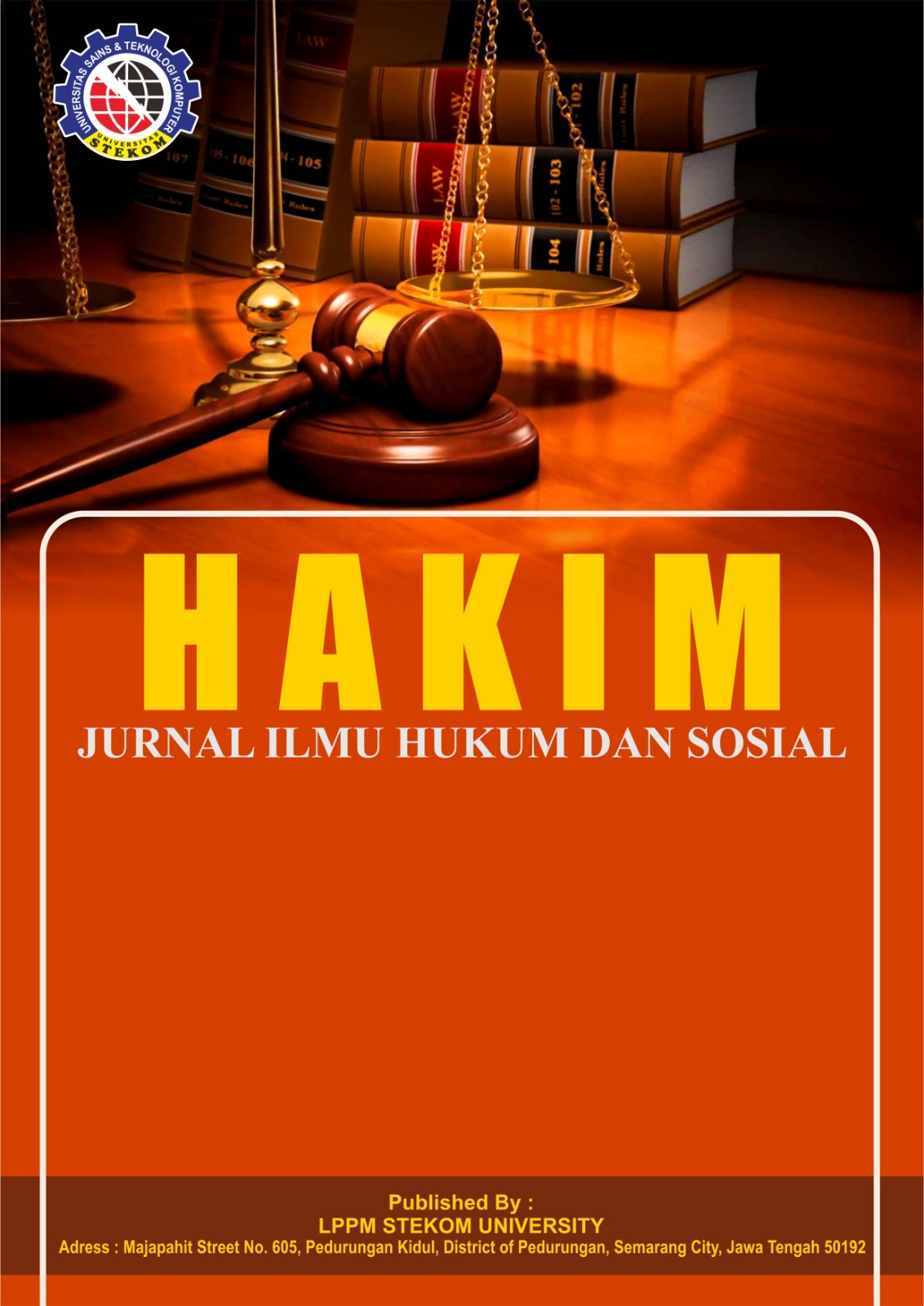Criminalization of Online Gender-Based Violence (OGBV): Challenges and Solutions in Indonesian Criminal Law
DOI:
https://doi.org/10.51903/hakim.v3i1.2297Keywords:
Online Gender-Based Violence (OGBV) , Criminal Law Reform , Legal Protection for Victims , Digital Violence Regulation , Law Enforcement EffectivenessAbstract
Online Gender-Based Violence (OGBV) is an escalating phenomenon in Indonesia, driven by the advancement of digital technology, which enables perpetrators to commit various forms of gender-based violence through online platforms. Data from the National Commission on Violence Against Women (Komnas Perempuan) indicate a sharp rise in OGBV cases, from 1,200 cases in 2018 to 8,500 cases in 2023, suggesting that existing regulations remain insufficient in providing adequate protection for victims. This study aims to analyze the challenges in the criminalization of OGBV in Indonesia and to evaluate the effectiveness of existing regulations, particularly the Electronic Information and Transactions Law (UU ITE) and the Indonesian Penal Code (KUHP). A juridical approach with qualitative analysis is employed, incorporating an examination of current regulations, case studies of court rulings, and interviews with victims and law enforcement officials. The findings reveal that sanctions imposed on perpetrators remain relatively lenient, with only 18% of reported cases being processed by law enforcement, and less than 6% resulting in convictions. Furthermore, existing regulations do not comprehensively address the various forms of OGBV, making it challenging for victims to seek justice. This study underscores the necessity for a more specific and gender-sensitive revision of criminal law to enhance victim protection. The findings are expected to serve as a foundation for policymakers in formulating more effective regulations to combat OGBV in Indonesia.
References
Agustina, R., & Purwanto, G. H. (2024). Kejahatan Impersonation terhadap Public Figure dalam Perspektif Undang-Undang Tindak Pidana Kekerasan Seksual (Studi Kasus di Kabupaten Bojonegoro). Jurnal Pembangunan Hukum Indonesia, 6(2), 315–327. https://doi.org/10.14710/jphi.v6i2.315-327
Akter, F., & Deeba, F. (2021). Psychological Reactions to Different Types of Gender-Based Violence in Women Survivors of Violence in the Context of a Developing Country. Journal of Interpersonal Violence, 37(21–22), 19961–19982. https://doi.org/10.1177/08862605211047966
Ananta, K. D., Ambodo, T., & Tohawi, A. (2024). Pengaruh Media Sosial terhadap Peningkatan Kejahatan Siber di Indonesia. Islamic Law: Jurnal Siyasah, 9(2), 118-13`. https://doi.org/10.53429/iljs.v9i2.858
Anggraini, M. (2024). The Urgency of Regulating Sexual Extortion in Online Gender-Based Violence from a Criminal Law Perspective. Journal of Law, Politic and Humanities, 5(1), 491–499. https://doi.org/10.38035/jlph.v5i1.867
Bansal, V., Rezwan, M., Iyer, M., Leasure, E., Roth, C., Pal, P., & Hinson, L. (2023). A Scoping Review of Technology-Facilitated Gender-Based Violence in Low- and Middle-Income Countries Across Asia. Trauma, Violence, & Abuse, 25(1), 463–475. https://doi.org/10.1177/15248380231154614
Bintari, A., Raya, J., Sumedang, B., 21, K., & Barat, J. (2024). Kekerasan Seksual Berbasis Elektronik: Permasalahan dan Respons terhadap Kasus. Jurnal Perempuan, 29(1), 17–29. https://doi.org/10.34309/jp.v29i1.960
Coe, P. (2022). The Draft Online Safety Bill and the Regulation Of Hate Speech: Have We Opened Pandora’s Box? Journal of Media Law, 14(1), 50–75. https://doi.org/10.1080/17577632.2022.2083870
Faith, B. (2022). Tackling Online Gender-Based Violence; Understanding Gender, Development, and the Power Relations of Digital Spaces. Gender, Technology and Development, 26(3), 325–340. https://doi.org/10.1080/09718524.2022.2124600
Hegarty, K. L., Andrews, S., & Tarzia, L. (2022). Transforming Health Settings to Address Gender-Based Violence in Australia. Medical Journal of Australia, 217(3), 159–166. https://doi.org/10.5694/mja2.51638
Hester, M., Williamson, E., Eisenstein, N., Abrahams, H., Aghtaie, N., Bates, L., Gangoli, G., Robinson, A., Walker, S. J., McCarthy, E., & Matolcsi, A. (2023). What is Justice? Perspectives of Victims-Survivors of Gender-Based Violence. Violence Against Women, 31(2), 570–597. https://doi.org/10.1177/10778012231214772
Huang, K. Y., Kumar, M., Cheng, S., Urcuyo, A. E., & Macharia, P. (2022). Applying Technology to Promote Sexual and Reproductive Health and Prevent Gender Based Violence for Adolescents in Low and Middle-Income Countries: Digital Health Strategies Synthesis from an Umbrella Review. BMC Health Services Research, 22(1), 1–27. https://doi.org/10.1186/s12913-022-08673-0
Medvi, A., & Syahminan, M. (2024). Strategi Komunikasi dan Penanggulangan Pelecehan Seksual dalam Media Sosial Tiktok. Jurnal Sains Sosio Humaniora, 8(1), 85–97. https://doi.org/10.22437/jssh.v8i1.36526
Molnar, L. I. (2022). “I Didn’t Have the Language”: Young People Learning to Challenge Gender-Based Violence through Consumption of Social Media. Youth, 2(3), 318–338. https://doi.org/10.3390/youth2030024
Nengyanti, Yusnaini, Imania, K., & Santoso, A. D. (2024). Policy Transfer for Sexual Violence Prevention and Management in Indonesian Higher Education Institutions. Multidisciplinary Journal of Gender Studies, 13(13), 137–155. https://doi.org/10.17583/generos.12738
Ostadtaghizadeh, A., Zarei, M., Saniee, N., & Rasouli, M. A. (2023). Gender-Based Violence Against Women During the Covid-19 Pandemic: Recommendations for Future. BMC Women’s Health, 23(1), 1–15. https://doi.org/10.1186/s12905-023-02372-6
Philbrick, W., Milnor, J., Deshmukh, M., & Mechael, P. (2022). Information and Communications Technology Use to Prevent and Respond to Sexual and Gender-Based Violence in Low-and Middle-Income Countries: An Evidence and Gap Map. Campbell Systematic Reviews, 18(4), 1277. https://doi.org/10.1002/cl2.1277
Polyzoidou, V. (2024). Digital Violence Against Women: Is There a Real Need for Special Criminalization? International Journal for the Semiotics of Law, 37(6), 1777–1797. https://doi.org/10.1007/s11196-024-10179-3
Putri, A., Sari, N., Fajrina, P., & Aisyah, S. (2025). Keamanan Online dalam Media Sosial: Pentingnya Perlindungan Data Pribadi di Era Digital (Studi Kasus Desa Pematang Jering). Jurnal Pengabdian Nasional (JPN) Indonesia, 6(1), 38–52. https://doi.org/10.35870/jpni.v6i1.1097
Rasiwan, I., Terranova, R., & Kartamulia, U. (2024). Pertanggungjawaban Pidana Pelaku Revenge Porn di Indonesia: Antara Celah Hukum dan Urgensi Perlindungan Korban. Jurnal Hukum Indonesia, 3(4), 158–167. https://doi.org/10.58344/jhi.v3i4.1106
Rohmawati, Junaidi, A., & Khaerudin, A. (2024). Urgensi Regulasi Penyalahgunaan Deepfake Sebagai Perlindungan Hukum Korban Kekerasan Berbasis Gender Online (KBGO). Innovative: Journal Of Social Science Research, 4(6), 1779–1794. https://doi.org/10.31004/innovative.v4i6.16559
Sharma, V., Ausubel, E., Heckman, C., Rastogi, S., & Kelly, J. T. D. (2022). Promising Practices for the Monitoring and Evaluation of Gender-Based Violence Risk Mitigation Interventions in Humanitarian Response: A Multi-Methods Study. Conflict and Health, 16(1), 1–27. https://doi.org/10.1186/s13031-022-00442-4
Sheikh, M. M. R., & Rogers, M. M. (2024). Technology-Facilitated Sexual Violence and Abuse in Low and Middle-Income Countries: A Scoping Review. Trauma, Violence, and Abuse, 25(2), 1614–1629. https://doi.org/10.1177/15248380231191189
Silalahi, T., & Panjaitan, J. D. (2023). The Mechanism of the Criminal Justice System in Indonesia Towards Women’s Legal Protection. International Journal of Social Research, 1(2), 69–81. https://doi.org/10.59888/insight.v1i2.9
Sorochinski, M., & Borukhov, E. (2024). Digital Shadows: Confronting the Rise of Technology-Facilitated Sexual Violence and the Quest for Systemic Solutions. Contemporary Justice Review, 27(2–3), 116–131. https://doi.org/10.1080/10282580.2024.2363429
Vahedi, L., Qushua, N., Seff, I., Doering, M., Stoll, C., Bartels, S. A., & Stark, L. (2023). Methodological and Ethical Implications of Using Remote Data Collection Tools to Measure Sexual and Reproductive Health and Gender-Based Violence Outcomes among Women and Girls in Humanitarian and Fragile Settings: A Mixed Methods Systematic Review of Pee. Trauma, Violence, and Abuse, 24(4), 2498–2529. https://doi.org/10.1177/15248380221097439
Vahedi, L., Stark, L., Ding, R., Masboungi, C., Erskine, D., Poulton, C., & Seff, I. (2024). A Qualitative Investigation of Gender-Based Violence Prevention and Response Using Digital Technologies in Low Resource Settings and Refugee Populations. European Journal of Psychotraumatology, 15(1), 1–16. https://doi.org/10.1080/20008066.2024.2347106
Wieberneit, M., Thal, S., Clare, J., Notebaert, L., & Tubex, H. (2024). Silenced Survivors: A Systematic Review of the Barriers to Reporting, Investigating, Prosecuting, and Sentencing of Adult Female Rape and Sexual Assault. Trauma, Violence, and Abuse, 22(5), 3742–3757. https://doi.org/10.1177/15248380241261404
Zviyita, I., & Mare, A. (2024). Same Threats, Different Platforms? Female Journalists’ Experiences of Online Gender-Based Violence in Selected Newsrooms in Namibia. Journalism, 25(4), 779–799. https://doi.org/10.1177/14648849231183815











3.png)
